The Wonders of Phang Nga Bay
Life offers up many bizarre experiences. For us, one of the most surreal was sitting in traffic jam on a rainy, dreary, cold winter day to, just 48 hours later, sitting in a boat in the middle of Phang Nga Bay.
If anyone asks the most memorable thing that we did on our first trip to Phuket over 20 years ago, this would be top of the list. No matter how many years pass, that memory remains firmly embedded in our minds.
Let’s be honest, for newcomers to Asia, there is a lot of culture shock. So much of what you see for the first time in the Eastern Hemisphere blows your mind.
So when someone asks us what are the “absolute must do things” for ticking all the boxes on their first trip to Phuket, a day out in Phang Nga has to be top of the list.
Phang Nga Bay is, quite simply, a natural marvel. It is an unforgettable experience, and a memory that you will always cherish.
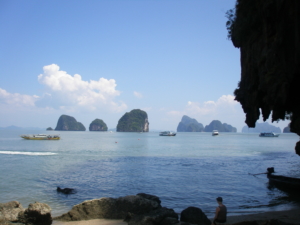
The Natural Wonder
Just seeing Phang Nga Bay for the first time is a trip (pardon the pun). The place in itself is an astonishing natural wonder and easily one of Asia’s most stunning maritime landscapes.
The whole bay is around 400 square km, so pretty big. Although it doesn’t quite compare to Ha Long Bay in Vietnam, which is around four times the size with over 2,000 individual islets, Phang Nga (with its 40 islets), is still a spectacle to behold.
It obviously took millions of years for the bay to look as it does today, which is why it is amazing that this stretch of water didn’t even exist a mere 10,000 years ago. If you were around back then, you could literally walk across the present-day bay between Phuket and Krabi Province.
Today, the limestone karsts seem to jut out of the sea, and each is an amazing and unique formation. No matter where you are in the bay, the scenery is stunning with beautiful views in every direction.
Proximity
Phang Nga Bay lies mostly in a northeasterly direction from Phuket. It can be reached by boat from a number of different marinas and ports on the east coast. To drive there, you cross the Sarasin Bridge from Phuket into Phang Nga Province.
Once you enter Phang Nga Province, the coastline adjacent to the bay has three different piers you can use, depending on where exactly you want to visit. It’s easy to find a traditional long tail boat at a reasonable price to take you wherever you want to go.
Although Phang Nga Bay is obviously a famous sightseeing tour offered in Phuket, it is actually a completely difference Province. People similarly associate Phi Phi Island with Phuket, but Phi Phi actually lies in Krabi Province.
Either way, most visitors to Phang Nga still fly into Phuket International Airport, and that’s likely to be the case until they open the new airport in Khao Lak (but we’re not sure when that will be).
Sailing in Phang Nga Bay
One of the nicest things about the bay is that, while it is quite large and goes all the way from Phuket, north to Phang Nga Province and across to Krabi Province, it is well sheltered so there are no rough waves.
This natural protection on all three sides means there is no need for Dramamine for those who suffer from seasickness. Even in the low season it is rare to get big waves in the bay.
Sailing around the bay is a wonderful experience. Just being on the open water, surrounded by such natural beauty is pure bliss. So if you are going to sail in the area, then a day or two around Phang Nga Bay is worthwhile before you head further afield.
It is easy to hire a sail boat for a day or more, and your hotel may even be able to assist you with this.
See our article: Go Sailing in Phuket
Phang Nga National Marine Park
Much of the bay has been protected as it lies within the Phang Nga National Marine Park. In 2002, the importance of Phang Nga Bay as an ecological area also received international recognition when it was declared a Ramsar site.
The Ramsar Convention on Wetlands is an intergovernmental treaty established under UNESCO, which aims to preserve important wetlands areas around the globe. As of May 2018 there 2,331 Ramsar Sites covering over 2.1 million square kilometres (810,000 sq mi).
We are pleased that Phang Nga Bay has received this special international designation. Hopefully, this global focus on the need conserve wetlands will see the bay remain just as it is for many years to come.
Mangrove Protection
Phang Nga Bay is home to a number of different mangrove species, most notably the dense mangrove forests on the northern perimeter of the bay which have been protected since area was declared a national park in 1981. From the air you can see that the entire coast line here is mainly mangrove swamp, and these native mangroves also stretch many kilometres inland among the bay’s many tributaries.
Mangroves are considered an extremely important part of the earth’s ecosystem, so they are also protected. They are found around the world in intertidal zones and are able to withstand the high levels of salinity from seawater, as well as surviving in the low-oxygen conditions of tidal mud.
If you ever get the chance to feel mangrove roots, they feel as strong as iron. These dense and complex root systems help to prevent coastal erosion and are vital barriers against storm surge, hurricanes and tsunamis. The roots also act as an effective salt filtration system, which is essential for stabilising the ecology of coastal areas.
Mangrove swamps have their own unique little ecosystems. Because nutrients are constantly being replenished by fresh water run off, mangroves support an entire population of bacteria, decomposers and filter feeders. These sustain worms, protozoa, barnacle, oysters and other invertebrates, which in turn feed fish and shrimp, which are fed upon by birds.
In some places mangrove swamps are absolutely teeming with wildlife, and act as a nursery for fish, as well as the perfect environment for certain species of crabs.
Other Phang Nga Bay Wildlife Wonders
But this is not the only wildlife which calls Phang Nga Bay home. From birds to numerous fish species, reptiles and amphibians, the bay is truly alive. If you are lucky, you might even spot a dolphin or a porpoise.
One day we were out on a boat and saw a huge manta ray jump out of the water and flop on its back, like a scene from a National Geographic documentary. It was an incredibly surreal experience to say the least (and naturally, our camera was not ready).
In total, Phang Nga Bay is home to 90 species of birds, as many types of fish, and if you have a keen eye from the boat, or you manage to venture inland a little, you may spot one of the nearly 20 different types of reptiles and 17 types of mammals.
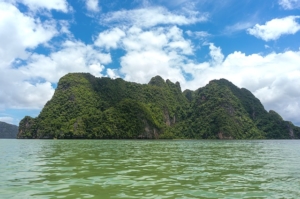
The “Hongs” of Phang Nga Bay
A quick Thai lesson: “hong” is the Thai word for “room”. They are called hongs because they are literally rooms within an island, formed by erosion of the limestone over many millions of years. These collapsed cave systems are apparently fairly typical in limestone karst systems.
So here’s a quick geology lesson: a karst is a landscape formed by rocks dissolving over very long periods of time, in the case of Phang Nga Bay, it is mostly limestone. As the rock dissolves it forms underground pits, sinkholes and caves.
As the caves form, and gradually get bigger, the roof of the cave gets so thin that eventually it just collapses. This forms lagoons and gorges inside the karst system.
So some of these islands, the most popular being Koh Phanak, are actually hollow in the middle with a perimeter wall and the only way to access them is through entrance caves that are generally only accessible at low tide.
Of all the trips we’ve been on in Phuket, exploring Phang Nga Bay has to be the number one to recommend.
See our article: Exploring the Caves in Phang Nga Bay in a Sea Canoe
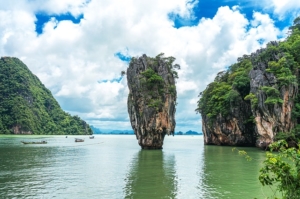
James Bond Island
For many, this is the highlight of the trip.
Every movie buff knows the MI6 agent with a license to kill, well after The Man With The Golden Gun was filmed here, 007 was kind enough to lend his name to this island in Phang Nga Bay.
Most of you would have seen the small island on post cards or advertisements for Thailand, but going there for yourself is a must.
See Our Article: A Visit to James Bond Island
The Sea Gypsies
The Bay is still home to communities of chao leh, or sea gypsies. Thought to be the very first coastal inhabitants of Phuket and Phang Nga Provinces, their exact origins are uncertain. What is certain is that they still fish the waters, and live a life not far removed from the one their ancestors lived hundreds of years ago.
Sadly, there is very little written history about these remarkable communities, but it widely accepted they were once nomadic in nature (hence their being called “gypsies” in English).
Phuket has a few different ethnic groups of sea gypsies, but If you’d like to see how they live in Phang Nga Bay, you are welcome to join them on the floating village in the very northernmost part of Phang Nga Bay.
Organized trips are available, and you can visit their handicrafts stalls and eat in one of their many restaurants.
See Our Article: The Amazing Gypsy Floating Village
Conclusion
Suffice it to say, there is a lot to do in Phang Nga Bay, from just soaking up the amazing scenery to actually “doing stuff”.
It is an amazing part of the world, with its distinctive karst systems with collapsed caves, amazing wildlife and natural tourist attractions.
If you find yourself in the region, be sure to visit Phang Nga Bay. If you live here in Phuket already, it’s an absolute travesty if you’ve never even been. If you have been, but not in a while, it takes a quite a few trips to get bored of Phang Nga Bay, so why not go back again soon.
If you are planning to take an organized tour, consider the attractions offered by each and the time you have available. Exploring the caves in a sea kayak, James Bond Island, the gypsy floating village – some trips may do all three. So choose your tour operator carefully, especially if you are budgeting your holiday time.
But what ever you do, please do not visit Phuket without a trip to these amazing and memorable attractions.
A day out in Phang Nga Bay is a memory that will surely last a lifetime.
See our other articles on what to do in amazing Phuket:
The Sea Turtles of Mai Khao Beach
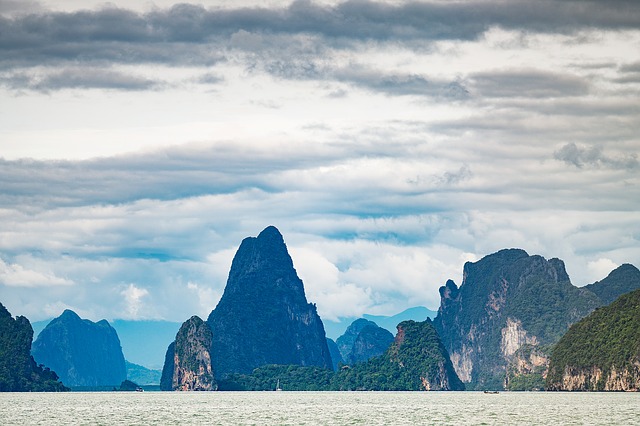
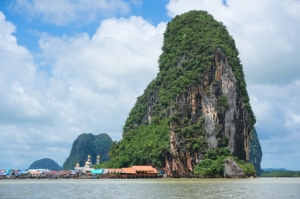
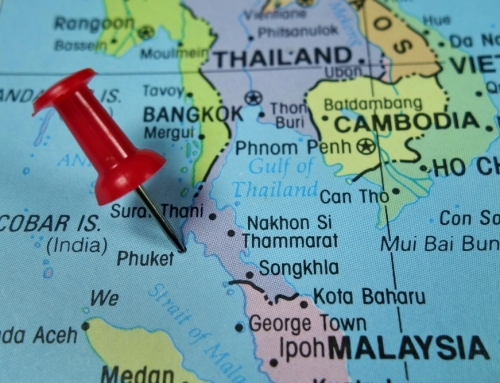



Social Contact